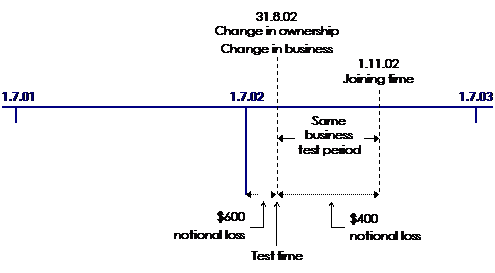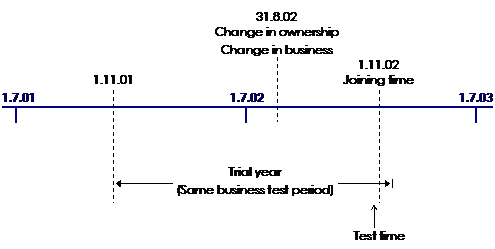Consolidation Reference Manual
You can still refer to the Consolidation reference manual for consolidation information that has not been impacted by changes in the legislation.
C3 Losses
C3-3 Worked example - loss transfer
Transfer testing
C3-3-270 Transfer testing where control or ownership failure and a change in business within the non-membership period
Description
This example shows how a company determines if a loss, or any part of a loss, is transferred to the head company at joining time where there has been a change in ownership accompanied by a change in business within the non-membership period.
Commentary
An entity [F1] that joins a consolidated group as a subsidiary member part-way through its income year must determine its income tax position for the period up until the joining time as if that period were an income year → paragraph 701-30(3)(a). This period, which begins at the start of the income year and ends just before the joining time, constitutes a non-membership period → paragraph 701-30(2)(b).
A joining company that experiences a change in ownership and a change in business within such a non-membership period determines its taxable income position under Subdivision 165-B [F2] . Subdivision 165-B applies to a company that has not had the same ownership and control during an income year, and has not satisfied the same business test → section 165-35.
Under Subdivision 165-B, the income year is divided into periods → section 165-45. The dividing points between periods are defined by a change in ownership or control. [F3] The notional loss or notional taxable income for each period is determined under specific rules for attributing assessable income and deductions to these respective periods.
The joining company's taxable income for the non-membership period in question is then worked out in accordance with section 165-65. Where a taxable income is worked out for one or more notional periods within the non-membership period and there are no other non-membership periods in the income year, this will be the taxable income for the entity in accordance with subsection 701-30(5). Notional losses are not taken into account in working out the taxable income but instead will determine the company's tax loss for the non-membership period, which is calculated in accordance with section 165-70. The tax loss of the joining company is transferred to the head company at the joining time if the transfer tests as described in Subdivision 707-A can be satisfied. Given that Subdivision 165-B is relied on by the joining company to work out its taxable income/tax loss position, it follows that the changes in ownership and business may result in none of the tax loss or only part of the tax loss satisfying the transfer tests.
Example
Facts
An entity (a company) joins a consolidated group on 1 November 2002 and remains a subsidiary member of the group for the remainder of the income year. It has a non-membership period from 1 July 2002 to 31 October 2002. The joining entity experiences a change in ownership within the non-membership period which results in a change in the business conducted. The joining entity is able to establish that the change in ownership occurred on 31 August 2002. The joining entity's tax deductions exceed assessable income throughout the non-membership period.
Figure 1: Joining entity timeline

Calculation
Step 1: Determine which losses remain unutilised at the joining time
The entity must work out its net tax position for the non-membership period. It needs to work out its taxable income (if any) for the period, the income tax (if any) payable on that taxable income and its loss (if any). These calculations are to be made as if the start and end of the period were the start and end of an income year → subsection 701-30(3). As a consequence of the ownership change, unless the entity satisfies the same business test for the rest of the non-membership period after the ownership change, Subdivision 165-B will apply to the non-membership period as if it were an income year. As illustrated in Figure 2, the entity is required to apply Subdivision 165-B to the non-membership period as if it were an income year.
Figure 2: Calculation of notional losses

Section 165-35 requires the company to apply the same business test to the business that it carried on immediately before the test time (the end of the first period) and the same business test period (the second period in this example). As the same business test is not satisfied, the entity is required to calculate the notional loss or notional taxable income for each period pursuant to section 165-50. The tax loss for the non-membership period is then calculated in accordance with section 165-70.
In this example it has been assumed that in the first period there is a notional loss of $600 and in the second period a notional loss of $400. In the absence of any other adjustments, the tax loss for the non-membership period is $1,000, being the sum of the two notional losses that remain unutilised at the joining time. For the purposes of transfer or utilisation, subsection 701-30(8) operates to deem the non-membership period loss of $1,000 as a tax loss for an income year starting on 1 July 2002 and ending on 31 October 2002.
Transfer testing of the loss can now proceed.
Step 2: Apply the continuity of ownership test
In this example there has been an ownership failure within the ownership test period 1 July 2002 to just after 1 November 2002. Accordingly, the tax loss would not be utilisable to the joining entity under this test in the trial year (assuming there is sufficient income). Section 165-10 provides an alternative qualifying test that requires the company to meet the conditions about carrying on the same business.
Figure 3: Continuity of ownership transfer test

Step 3: Identify the modified same business test points
The company is required to apply the modification to the same business test as stipulated in section 707-125 and work out whether the entity satisfies the same business test for:
- •
- the same business test period, consisting of:
- -
- the trial year, and
- -
- the income year that included the test time that would normally apply for the same business test (the 'change year'), if that income year started before the trial year, and
- •
- the test time, being the time just before the end of the income year for which the loss was made by the company.
As shown in Figure 4, the same business test period is effectively the trial year, because the change year falls within the trial year period.
Figure 4: Modified same business test points

Step 4: Apply the same business test
The joining entity now applies the section 165-210 same business test to the identified same business test period and test time [F4] to work out whether the loss is transferred. This test will be satisfied if throughout the same business test period the entity carries on the same business as it carried on at the test time. As noted in Figure 4, the entity had a change in business as a result of the change in ownership. Therefore it would similarly fail this qualifying test.
Step 5: Determining whether part of the tax loss can be deducted
As the entity has failed both the continuity of ownership and same business tests, section 165-10 prevents the company from deducting the tax loss. However, section 165-20 may operate to allow a part of the tax loss to be deducted. Under section 165-20, a company can deduct a part of a tax loss that was incurred during a part of the loss year if, assuming that part of the loss year had been treated as the whole of the loss year for the purposes of section 165-10, the company would have been entitled to deduct the tax loss.
Figure 5: Transfer testing applying section 165-20

Conclusion
In this example, the continuity of ownership test will be satisfied for the part of the loss year beginning immediately after the ownership change and ending just before the joining time. Note that subsection 701-30(3A) extends the non-membership period to just after the joining time for the purposes of testing for continuity of ownership. As the notional loss for that particular period is $400, this will be the amount that is utilisable under section 165-20. Therefore, this amount of $400 will be the amount of the tax loss that is transferred to the head company at the joining time under section 707-120. The part of the tax loss that is not transferred is not able to be utilised by any entity for an income year ending after the joining time → section 707-150.
References
Income Tax Assessment Act 1997:
- •
- section 701-30
- •
- Subdivision 165-B
- •
- Subdivision 165-A
- •
- Section 165-210
- •
- section 36-25
- •
- Subdivision 707-A
History
Revision history
C3-3-270 first published 3 November 2004.
Proposed changes to consolidation
Proposed changes to consolidation announced by the Government are not incorporated into the Consolidation reference manual until they become law. In the interim, information about such changes can be viewed at:
- •
- http://assistant.treasurer.gov.au(Assistant Treasurer's press releases)
- •
- www.treasury.gov.au (Treasury papers on refinements to the consolidation regime).
Current at 3 November 2004
That was not a member of another consolidated group.
Section 36-25 directs the company to the special rules in Subdivision 165-B.
However, if the same business test is satisfied after the change in ownership or control, it is possible that what would otherwise be two or more successive periods are treated as a single period.
As identified in step 3 by applying the modification in section 707-125.
Copyright notice
© Australian Taxation Office for the Commonwealth of Australia
You are free to copy, adapt, modify, transmit and distribute material on this website as you wish (but not in any way that suggests the ATO or the Commonwealth endorses you or any of your services or products).
